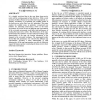Free Online Productivity Tools
i2Speak
i2Symbol
i2OCR
iTex2Img
iWeb2Print
iWeb2Shot
i2Type
iPdf2Split
iPdf2Merge
i2Bopomofo
i2Arabic
i2Style
i2Image
i2PDF
iLatex2Rtf
Sci2ools
CHINZ
2006
ACM
2006
ACM
Where you point is where the robot is
It is virtually envisioned that in the near future home-service robots will be assisting people in their daily lives. While a wide spectrum of utility of home-service robots has been proposed, i.e., cleaning, surveillance or go-and-fetch jobs, usability studies of the home-service robots have been less undertaken. This paper explores the usability issues, in particular, a map-based user interface for instructing home-service robots in the home environment. It focused on how the different map representation of the co-located environment would affect task performance of locating the home-service robots. The effectiveness of the mapbased human-robot interface was thus analysed according to the dimensionality of the map, the location information of the elements in the co-located workspace. The experimental results showed that task performance was varied by the different map representation, providing a better understanding of what characteristics of the map representation were able to effe...
CHINZ 2006 | Future Home-service Robots | Home-service Robots | Human Computer Interaction | Task Performance |
| Added | 13 Jun 2010 |
| Updated | 13 Jun 2010 |
| Type | Conference |
| Year | 2006 |
| Where | CHINZ |
| Authors | Hokyoung Ryu, Woohun Lee |
Comments (0)

